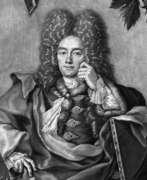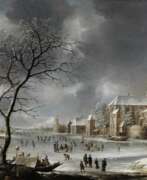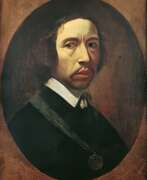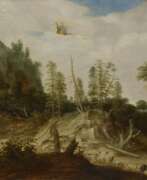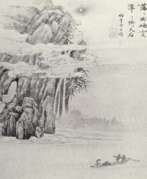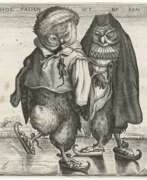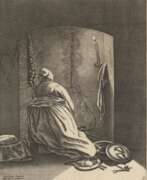Landscape painters 17th century


Hendrick Avercamp was a seminal Dutch painter during the Dutch Golden Age. He is celebrated as one of the earliest landscape painters of the 17th-century Dutch school, specializing in vibrant winter scenes of the Netherlands. His paintings are filled with colorful and lively depictions of people engaging in various activities against the backdrop of the Dutch winter landscape.
Educated by the Danish-born portrait painter Pieter Isaacsz, Hendrick Avercamp's work reflects a strong influence from the Flemish painting tradition, especially evident in the landscapes reminiscent of Pieter Bruegel the Elder. His technique of aerial perspective, where objects in the foreground are painted with richer colors than those in the distance, creates a remarkable impression of depth in his paintings.
Hendrick Avercamp's most ambitious and acclaimed work, 'Winter Landscape with Ice Skaters', painted around 1608, is a detailed panorama of human and animal activities during a harsh winter. This painting, along with others like 'Winter Landscape with a Frozen River and Figures' and 'Winter Landscape with Skates and People Playing Golf', showcase his knack for narrative, capturing various facets of 17th-century Dutch society enjoying the winter season.
Despite being mute and probably deaf, Hendrick Avercamp's keen observation skills are evident in his works, where he intricately portrays diverse classes engaging in various winter activities. He produced about a hundred paintings, many of which can be seen in the Rijksmuseum in Amsterdam and the Mauritshuis in The Hague. His work was also celebrated for its historical quality, providing a glimpse into the life of different societal levels in the Netherlands at that time.
For collectors and enthusiasts of art and antiques, Hendrick Avercamp's paintings offer a fascinating window into the Dutch Golden Age, with their vivid portrayal of life and activities in a winter setting. His works, characterized by meticulous detail and a cheerful narrative, remain an integral part of the conversation in the history of Dutch art.
To stay updated on the latest insights and collections related to Hendrick Avercamp's works, consider subscribing to our updates. Stay informed about new sales, exhibitions, and auction events featuring this master of Dutch winter landscapes.


Barent Avercamp was a Dutch painter. He was taught by his uncle Hendrick Avercamp, who was also a painter. Barent primarily painted scenes depicting Netherlands in winter. He was a member of the Guild of Saint Luke, and traveled around the Netherlands including Zwolle and Zutphen for his settings and inspiration.


Elias Baeck called "Heldenmuth", was a German painter and engraver from Augsburg. Baeck worked for some time in Rome, then in Laybach, but finally returned to Augsburg, where he died in 1747. His chief works — both in painting and engraving — were portraits and landscapes. His engravings are sometimes signed "E.B.a.H.", standing for "Elias Baeck, alias Heldenmuth".


Ludolf Bakhuizen was a Dutch painter of the 17th and early 18th centuries. He is known as an outstanding master of seascapes. Bakhuizen also painted biblical themes and portraits of his contemporaries as well as engravings and miniature models of ships.
Ludolf Bakhuizen is considered one of the best marine painters of the Golden Age of Dutch painting. Among the admirers of his work were many influential European rulers, including the Russian Tsar Peter the Great. The master met Peter I, who visited Amsterdam in the mid-1690s and, according to contemporaries, even managed to give some painting lessons to the Russian tsar. In addition, Вakhuizen made models of all kinds of ship designs on commission from Peter the Great.
Toward the end of his life, the Amsterdam authorities honored Bakhuizen by opening his own gallery on the top floor of the City Hall for his achievements in the fine arts. The best masterpieces of his work are now preserved in museums in the Netherlands, Germany, England, France, and Italy.


Abraham Bloemaert was a Dutch painter, draughtsman, and printmaker from the Golden Age of Dutch painting, one of the founders of the Guild of St. Luke in Utrecht. Bloemart was a caravagist. He painted mainly landscapes, mythological and biblical scenes, and pastoral works.


Romolo Panfi was an Italian painter, of the late Baroque period, active mainly in Florence. He was active mainly as a battle painter and landscapes. He was a pupil of Jacopo Vignali and worked in the Medici court of Grand Duke Ferdinand and his brother, Cardinal Leopoldo de' Medici. He trained under Giovanni Camillo Sagrestani. He executed works in the church of San Frediano in Cestello, in the Oltrarno district of Florence. He also painted for the Palazzo Capponi-Covoni near the Nunziata in Florence.
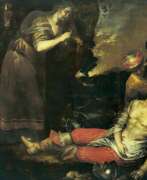

Luciano Borzone was an Italian painter of the late Mannerist and early Baroque periods, working mainly in Genoa. After an apprenticeship with Filippo Bertolotto, his uncle, Duke Alberigo of Massa Lunigiana, patronised his work as a pupil of Cesare Corte.
Luciano Bordzone was an outstanding portrait painter. In Genoa he painted the Purification for the church of San Domenico and the Baptism of Christ for the church of Santo Spirito.


Pieter Bout was a Flemish painter, draughtsman and etcher. He is known mainly for his landscapes, city, coast and country views and architectural scenes painted in a style reminiscent of earlier Flemish masters such as Jan Brueghel the Elder.
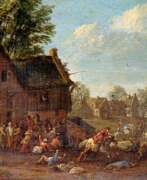



Paul Bril was a prominent Flemish painter, best known for his significant contributions to landscape painting. Born around 1554 in Antwerp, he later moved to Rome, where he became a central figure in the art scene, influencing the Italian and Northern European landscape painting traditions.
Paul Bril's early works were steeped in the Flemish manner, exhibiting a picturesque arrangement of landscape elements with dramatic contrasts of light and dark. His style evolved during his stay in Rome, influenced by the work of Annibale Carracci and Adam Elsheimer. By around 1605, Bril's compositions became more serene and classical, showcasing calmer transitions from foreground to background and embracing pastoral and mythological themes.
Paul Bril's contributions extended beyond his paintings. He was a respected figure in Rome's art community, becoming the first foreign director of the Accademia di San Luca in 1621. His patrons included some of the most influential families in Rome, and his work was sought after by collectors and fellow artists. Bril's influence was profound, impacting future generations of artists, including the Dutch Italianates and genre painters active in Rome.
His works can be found in prestigious galleries worldwide, illustrating his enduring legacy in the art world. For collectors and art and antiques experts, Paul Bril's work represents a significant period in the evolution of landscape painting, blending Flemish traditions with Italian classicism.
For those interested in exploring the captivating landscapes and historical significance of Paul Bril's art, staying informed about new product sales and auction events is essential. Signing up for updates can provide valuable insights and opportunities to acquire pieces associated with this influential artist.


Pieter Brueghel the Younger was a Flemish artist celebrated for his detailed landscapes, religious themes, proverbs, and vibrant village scenes. Despite being the son of the illustrious Pieter Bruegel the Elder, Brueghel the Younger carved out his own niche in the art world, earning the moniker 'Hell Brueghel' for his dynamic scenes of fires and energetic copies of his father's peasant life portrayals.
Brueghel the Younger's original creations, such as "The Village Lawyer," showcase his keen observation of village life, merging the energy and boldness of 17th-century style with his father's idiom. His work is characterized by its lively, picturesque depiction of peasants, albeit some critics argue they lack the subtlety and humanism of his father's creations. Despite this, Brueghel the Younger's legacy includes a significant number of original works and copies that were rediscovered in the 20th century, highlighting his contribution to the Flemish painting tradition.
His workshop was known for its prolific output, especially in producing copies of Bruegel the Elder's compositions, a testament to the enduring popularity and influence of the Bruegel family's artistic legacy. However, Brueghel the Younger also impressed with his unique compositions, contributing to the genre of still life and village scenes with a distinct style that resonated well into modern times.
For collectors and experts in art and antiques, Pieter Brueghel the Younger's works represent an important period in Flemish art, offering insights into the evolution of genre painting and the detailed portrayal of rural life. His paintings, held in esteemed collections worldwide, continue to be studied and admired for their vibrancy, narrative quality, and historical value.
To explore more about Pieter Brueghel the Younger and to stay updated on sales and auction events related to his work, signing up for specialized updates can offer exclusive insights into the world of this influential Flemish painter. This subscription ensures enthusiasts and collectors are well-informed about developments related to Brueghel the Younger's oeuvre, enhancing their appreciation and understanding of his artistic legacy.


Jan Bruegel the Younger was a Flemish Baroque painter. He was the son of Jan Brueghel the Elder, and grandson of Pieter Bruegel the Elder, both prominent painters who contributed respectively to the development of Renaissance and Baroque painting in the Habsburg Netherlands. Taking over his father's workshop at an early age, he painted the same subjects as his father in a style which was similar to that of his father. He regularly collaborated with leading Flemish painters of his time.


Peter Candid was a Flemish painter, tapestry designer, draughtsman and sculptor.
Pieter Candide worked mainly in Italy and Germany. He was an artist at the court of the Medici in Florence and at the Bavarian court of Duke Wilhelm V and his successor Maximilian I in Munich.
His paintings range from historical paintings, portraits, mythological scenes and allegories. He created large altarpiece images as well as complex decorative designs.
Candide's style was characterised by a combination of Italian and Flemish influences, with a particular emphasis on detailed, realistic depictions of the human form.


Bernardino Capitelli was an Italian painter and etcher of the Baroque period. Capitelli achieved the unique position of virtually the only tenebrist etcher in Italy. The use of abrupt contrasts of light and dark is characteristic of Capitelli's work.


Luca Carlevarijs was an Italian painter and engraver working mainly in Venice. He pioneered the genre of the cityscapes (vedute) of Venice, a genre that was later widely followed by artists such as Canaletto and Francesco Guardi.


Michiel Carree of Karé was a Dutch painter and decorator of the Golden Age.
Carree was a famous landscape painter: King Frederick of Prussia invited him to Berlin and appointed him court painter. After the king's death, he returned to Holland and was mainly engaged in decorating the palaces of the noble townspeople. Carrée often depicted livestock in his landscapes, and these paintings can now be seen in the Rotterdam Museum.


Viviano Codazzi, an Italian painter, was renowned for his architectural paintings, capricci, and vedute, particularly active during the Baroque period. His works, which blend architectural precision with imaginative landscapes, gained significant popularity in mid-17th century Rome, appealing to a shift in art patronage dynamics. Codazzi's paintings, often set in a landscape context, include ruins, idealized architecture, or fanciful scenes, showcasing his mastery in linear perspective and a deep understanding of antique aesthetics.
Viviano Codazzi's artistry was not confined to painting alone; he collaborated with figure painters like Michelangelo Cerquozzi and Domenico Gargiulo, adding vibrancy and life to his architectural canvases. His paintings like "The Nativity in an ancient ruin" and "St. Peter's Basilica" from 1636 illustrate his ability to merge topographical accuracy with artistic creativity. Codazzi's influence extended beyond his lifetime, with his sons and other artists following in his footsteps, contributing to the legacy of architectural painting in the Baroque era.
His works are held in high esteem and are part of collections in prestigious institutions such as the Prado, Uffizi, and Galleria Spada. For collectors and art enthusiasts, Viviano Codazzi's paintings offer a glimpse into the architectural and artistic sensibilities of the 17th century, making them valuable pieces in the realms of art and antiques.
For those interested in exploring and perhaps acquiring pieces of Viviano Codazzi's enduring legacy, staying updated on new sales and auction events is crucial. Signing up for updates can provide invaluable insights into opportunities to own a piece of this architectural painting heritage.


Jacob Gerritsz. Cuyp was a Dutch painter-painter and illustrator of the Golden Age, the elder brother of Benjamin Gerritsz. Cuyp. He was a member of the Dordrecht and Utrecht Guilds of St. Luke's. The prolific painter produced a large number of portraits, including many portraits of children. He also painted historical, biblical and genre scenes, still lifes and landscapes.


Gijsbert d'Hondecoeter was a Dutch landscape and animalier painter.
Hondecoeter belonged to a family of painters. His father was Gillis d'Hondecoeter and his son was Melchior d'Hondecoeter. Hondecoeter primarily painted works of barnyard fowl. Some of his works can be found at the Rijksmuseum Amsterdam. He became a member of the Guild of St. Luke in Utrecht in 1629. After he died in 1653, his brother-in-law and artist Jan Baptist Weenix continued the training of his son Melchior.


Marcus de Bye (sometimes spelt de Bie or de Bije) was a Dutch painter and engraver. He learnt to paint under Jacob van der Does, and produced some landscapes with animals in the style his teacher, but he is best known for his etchings of animals, after the designs of Paulus Potter and Markus Gerard II. Member of Confrerie Pictura.


Willem de Heusch is a Dutch landscape painter and printmaker.
Willem de Heusch probably studied under Jan Both, as he later painted and etched entirely in his style. De Heusch signed his paintings with his full name beginning with a monogram.
Willem de Heusch was known for his realistic depictions of Dutch landscapes. He used a naturalistic style in his works that was characterized by his attention to detail and skilful use of light and shade.
Although Heusch's style is identical to Botha's, both masters may have been influenced by Claude Lorrain, whose Arcadian art they imitated, during their travels in Italy. Heusch sometimes sketched landscapes for the battle paintings of Jan Molenard.


Pieter de Molijn, a distinguished Dutch Golden Age painter and engraver, was celebrated for his exceptional landscapes, genre pieces, and more. Born in London in 1595 to Flemish parents, he moved to the Netherlands, where he significantly contributed to Dutch art. Molijn was not just a painter; his talents extended to engraving, a testament to his versatility in the art world.
Pieter de Molijn's journey into art took him to Italy and then to Haarlem, where he joined the Guild of St. Luke in 1616, marking the start of a prolific career. His landscapes, known for their sweeping diagonals and tonal unity, helped pioneer a new style that influenced contemporaries and successors alike. Molijn's ability to capture the essence of the Dutch landscape made his works sought after, not just during his lifetime but also in today's art circles.
His works, like the captivating "Landscape with Figures," showcased at The Metropolitan Museum of Art, continue to fascinate art enthusiasts and collectors. Pieter de Molijn's artistry wasn't confined to landscapes alone; his genre pieces and marine scenes also garnered acclaim, reflecting his diverse skills and innovative approach.
For art collectors and experts keen on Dutch Golden Age paintings, Molijn's works represent a blend of technical mastery and artistic vision. Whether it's his detailed landscapes or compelling genre scenes, each piece invites viewers into the world he saw and experienced.
For those who appreciate the finesse of Dutch Golden Age art, staying updated on Pieter de Molijn's works is a must. Whether it's auctions, exhibitions, or private sales, sign up for updates and never miss out on the opportunity to explore or acquire Molijn's timeless masterpieces.


Frederik de Moucheron the Elder was a Dutch landscape painter of the Dutch Golden Age.
Frederik studied under Jan Asselain (1610-1652), then spent three years in Paris before settling in Amsterdam in 1659. De Moucheron painted French, Italian and Dutch landscapes, reproducing with particular care the effects of sunset and gray clouds. Works by this artist are represented in many European art galleries, such as those in St. Petersburg and the Dresden Gallery.
He was the father of the landscape painters Isak de Moucheron and Frederik de Moucheron the Younger.


Adriaen van de Velde was a Dutch painter, draughtsman and print artist. His favorite subjects were landscapes with animals and genre scenes. He also painted beaches, dunes, forests, winter scenes, portraits in landscapes, as well as mythological and biblical scenes. He belongs to a group of painters referred to as the Dutch Italianate painters, who combined Dutch agricultural landscapes with mythological or Arcadian scenes in Italian settings. His paintings are characterised by their delicate, careful composition and his mastery of lighting effects as well as the human figure.


Cornelis Gerritsz. Decker was a Dutch landscape painter of the Golden Age of Dutch painting, and a member of the Haarlem Guild of St. Luke.
Decker painted mainly landscapes, often depicting architecture and adding animal and human figures. The artist also created interesting genre scenes from the workshops of ordinary people.


Jan Jansz. den Uyl was a painter of the Dutch Golden Age. He very much specialized in the form of still life known as the breakfast piece, or, in the elaborate style of painters like den Uyl, banquet pieces (banketjestukken). He also painted landscapes and animal paintings.


Joost Cornelisz. Droochsloot was a Dutch painter of the Dutch Golden Age, member of the Guild of St. Luke in Utrecht. He was a versatile painter, painting landscapes, moral allegories, and biblical stories. But he was mainly known for his genre rustic scenes with many participants, these paintings often had a moral component. In his compositions, Drochslot paid much attention to detail and signed them with the monogram "JCODS."


Gaspard Duguet, also known as Gaspard Poussin, was a French painter specialising in landscape painting. He was born into a family of French painters who settled in Rome.
Gaspard Duguet received his artistic training from his uncle, Nicolas Poussin, who was one of the leading Baroque painters. Duguet's early works were strongly influenced by Poussin's style, which emphasized clarity and orderliness of composition.
In the 1650s, Duguet began to develop a style of his own, characterized by his bold brushwork and vibrant use of colour. He became known for his ability to create dramatic and atmospheric landscapes, often depicting scenes from the Roman countryside.
Gaspar Duguet's paintings have a sense of grandeur and monumentality. His landscapes often feature classical ruins and ancient monuments, giving his works a sense of historical depth and resonance.


Jacques Fouquières, an eminent Flemish landscape painter active in the early 17th century, was celebrated for his detailed and atmospheric landscapes. Born around 1580 and active mainly in France, Fouquières's artistry flourished in a period rich in landscape painting. His style was heavily influenced by the Northern style prevalent during the late 16th and early 17th centuries, characterized by wide, panoramic landscapes with craggy rocks and a blue-greenish palette.
Fouquières's work was not just confined to painting; he was also a skilled draughtsman. His early works, like the "Winter Landscape" of 1617 in the Fitzwilliam Museum, showcase the influence of artists such as Joos de Momper, Jan Brueghel the Elder, Adriaen van de Venne, and Hendrick Avercamp. This particular painting is notable for its portrayal of a cold, wintry scene, exhibiting a mastery of the Northern landscape tradition. However, in his 1622 Forest Landscape, now in the Wallraf–Richartz Museum, Fouquières broke from this tradition, opting for narrower focuses and darker, more concentrated depictions of trees.
One of his notable works, "Landscape with ruins, people and animals," is preserved in The Metropolitan Museum of Art. This piece exemplifies Fouquières's talent in creating engravings, a medium that allowed him to capture intricate details of landscapes and everyday life.
His legacy extends beyond his works; he was a teacher to notable artists like Philippe de Champaigne and Matthieu van Plattenberg. Despite the success in his early career, his life ended in relative poverty, as evidenced by the modest inventory of his estate.
For collectors, auctioneers, and experts in art and antiques, the works of Jacques Fouquières represent a significant period in the history of landscape painting. His contributions to the art world during a pivotal era in European art history continue to be celebrated and studied.
If you have a keen interest in Jacques Fouquières's works or wish to stay informed about sales and auctions of his art, subscribing to updates would be beneficial. This will ensure you receive timely information about new sales and auction events related to his art.


Peeter Gijsels was a Flemish painter of the Baroque period.
Peeter Gijsels is known for his landscapes, architectural compositions and still lifes. He is also considered a genre painter as he painted scenes of village markets and church kermis. His landscapes in the style of Jan Bruegel the Elder were in great demand during his time.


Antonio Giusti was an Italian painter of the Baroque period, active mainly in Florence. He was a pupil of the painters Cesare Dandini and Mario Balassi. Giusti was known for his landscape paintings, in the style of Salvatore Rosa. Among those who studied with Giusti, was Giovanni Camillo Sagrestani.


Jan Griffier the Younger was an 18th-century painter active in England.
According to the Netherlands Institute for Art History he was the son of Jan Griffier I and the younger brother of Robert. He lived on Pall Mall and influenced the painter Christian August Lorentzen.
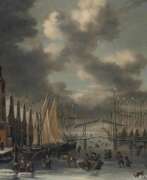

Thomas Heeremans was a Dutch painter and art dealer. He is known for his landscapes of winter scenes, cityscapes, harbor scenes, beach views, river views and village scenes. He was influenced by Klaes Molenaer, a slightly older painter also from Haarlem.


Wenceslaus Hollar, born on July 13, 1607, in Prague, was a Bohemian artist acclaimed for his etchings and engravings. His journey in art began in Germany, where he studied under the engraver Matthäus Merian. Hollar's career flourished when he moved to England, where he worked for various print sellers and publishers, including the notable John Ogilby and antiquarian Sir William Dugdale.
Hollar is remembered for his intricate and detailed works that include over 2,000 pieces, ranging from classical and historical subjects to portraits, costumes, and topographical scenes. His skill in translating texture into the etched medium was unparalleled, even as he lost most of the sight in one eye. Some of his most significant works include "Views of London," created after the Great Fire of London in 1666, which became valuable historical records of the city.
Tragically, Hollar's life was marked by hardships, including financial struggles and the loss of his young son to the plague. Despite these challenges, his dedication to his craft never waned. He continued to produce high-quality works until his death on March 25, 1677, in extreme poverty. Today, his works are held in high regard and are preserved in prestigious collections such as the British Museum in London and the National Gallery in Prague.
Hollar's legacy is a testament to his exceptional talent and his ability to capture the essence of his subjects with precision and depth. His works continue to be a rich source of historical and artistic knowledge, particularly for collectors, auctioneers, and experts in art and antiques.
For those interested in the remarkable etchings and engravings of Wenceslaus Hollar, staying informed about exhibitions and sales of his work can offer valuable insights into his unique artistic perspective.


Albert Jansz. Klomp was a Dutch painter of the Golden Age of Dutch painting who specialised in painting rural landscapes with animals.
Albert Klomp's paintings resemble those of Paulus Potter. Both artists have similar subjects and style, and Klomp's work has been erroneously attributed to Potter in the past.
Klomp's typical pastoral landscapes can be seen in many of the world's museums.


Philips Koninck was a Dutch landscape painter and younger brother of Jacob Koninck.
He painted chiefly broad, sunny landscapes, full of space, light and atmosphere; they are seen from a high perspective, allowing a prominent view of the sky. Portraits by him, somewhat in the manner of Rembrandt, also exist; there are examples of these in the galleries at Copenhagen and Oslo.


Jean Lemaire was a French painter. He is also known as Lemaire-Poussin, due to his frequent close collaborations with Nicolas Poussin. He specialised in landscapes and classical architectural scenes, populated with mythological figures in classical dress.


Francis Lepipre was an English painter of Flemish origin. Lepipre travelled extensively on the continent and his close study of the works of the great artists made him an excellent draughtsman.
Francis Lepipre painted landscapes, humorous compositions and caricatures, often carving subjects into silver plates for his friends, who used them as lids for tobacco boxes.


Gijsbrecht Leytens was a Flemish landscape painter of the Early Baroque period. He was famous for his depiction of winter landscapes, which were considered his speciality and were characterised by a highly individualised style. He is considered one of the least studied Flemish painters of the Antwerp School.
Geisbrecht Leitens became a member of the Guild of Saint Luke in Antwerp in 1611. From that time he was entitled to open his own workshop in the city and train apprentices.
The master carefully observed winter nature and birds and developed an individual manner which distinguished him from the philosophical generalisations of Pieter Bruegel the elder or the cosy details and findings of Lucas van Falkenborgh. Trees in his paintings are usually depicted covered in snow, often oddly shaped. The branches of the denuded trees are replete with representations of various birds. The artist's creative style may have been influenced by paintings from the Dutch Mannerism period.


Claude Lorrain was a renowned French artist celebrated for his exquisite landscape paintings. His works, which often depicted idealized landscapes, were infused with a poetic rendering of light, making them influential far beyond his lifetime, especially in England from the mid-18th to mid-19th century.
Claude Lorrain's journey into art began in his youth, though his early life details vary among sources. Some accounts suggest he was apprenticed to a pastry baker before being taken under the wing of artists like Goffredo Wals and Agostino Tassi in Italy, where he spent much of his life. Claude Lorrain's artistic skills flourished in Rome, leading him to join the Accademia di San Luca by 1633. His unique style attracted an international clientele, prompting him to create the Liber Veritatis, a catalog of his works to deter forgeries.
He was a master at integrating architecture within his landscapes, creating serene, harmonious scenes that reflected a nostalgia for a classical past. Works like "Ulysses Returning Chryseis to Her Father" exemplify his ability to evoke mood and atmosphere, capturing the essence of light and space. Claude Lorrain's influence extended to various art forms, inspiring poets like John Keats and setting a precedent in landscape painting that endured through the centuries.
For collectors and art enthusiasts, Claude Lorrain's paintings are not just visual treats but historical artifacts that offer insights into 17th-century landscape painting. His works are housed in prestigious galleries worldwide, serving as a testament to his enduring legacy in the art world.
For those interested in the art and legacy of Claude Lorrain, consider signing up for updates on new product sales and auction events related to this iconic artist. This subscription is an excellent opportunity for collectors and experts in art and antiques to stay informed about Claude Lorrain's enduring influence in the world of art.
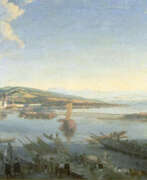

Conrad Meyer, a Swiss painter, engraver, and medallist, made significant contributions to the art world of his time. Initially a painter of portraits and landscapes, Meyer eventually shifted his focus to copper engraving, producing over a thousand works in his lifetime. Notable among his creations is the map of Switzerland by Conrad Gyger, which he produced in 1657, and his Planisphaerium Coeleste from 1681.
Conrad Meyer's artworks, such as "The Wild Man" (1649), "The Devil's Kitchen Visited by an Angel," and "Allegory of the Transience of Life" (1651), showcase his meticulous technique and are held in high regard, with several pieces housed in the Metropolitan Museum of Art. His work "Parable of the Ungrateful Servant" is part of the Philadelphia Museum of Art's collection, demonstrating his prowess in etching as well.
For art collectors and experts, Conrad Meyer's contributions to Swiss art and engraving offer valuable insights into the 17th-century European art scene, particularly in the context of Zurich. His legacy is encapsulated in the diverse range of subjects he explored, from detailed landscapes to intricate portraits and allegorical scenes, reflecting the cultural and artistic vibrancy of his era.
If you are an enthusiast or collector keen on Conrad Meyer's art, consider signing up for updates related to new sales and auction events concerning his works. This will ensure you stay informed about opportunities to acquire pieces connected to this notable Swiss artist.


Jan Christiaensz. Micker was a Dutch landscape painter of the Golden Age of Dutch painting.
Jan Micker worked as a painter from 1618 until his death. He was the first teacher of Jan Baptist Wenix and painted staffage in the paintings of Jan Franz Dammeroen, Hans Jurriens van Baden and Joachim Goverts Kamphuizen. His most famous painting is Vogelflücht, which depicts Amsterdam from a bird's eye view. The painting was created around 1652 and is now in the Amsterdam Museum.


Claes Moeyaert, or Nicolaes Cornelisz. Moeyaert, or Claes Cornelisz. Moeyaert, or Claes Cornelisz. Moeyaert, was a Dutch Baroque painter.
Moeyaert was a very prolific painter, he painted many biblical and mythological scenes with a special emphasis on dramatic moments. He followed Adam Elsheimer, Peter Lastman, Jan and Jacob Pinas, coming under the influence of Rembrandt himself in the mid-1630s. Moeyaert also designed Amsterdam's triumphal arch for the arrival of Maria de' Medici.


Joos de Momper the Younger was a Flemish landscape painter active in Antwerp between the late 16th century and the early 17th century. Brueghel's influence is clearly evident in many of de Momper's paintings. His work is situated at the transition from late 16th-century Mannerism to the greater realism in landscape painting that developed in the early 17th century. He achieved considerable success during his lifetime.


Isaac van Ostade was a Dutch painter. He was the brother and pupil of Adriaen van Ostade, who influenced his first works. Despite his short lifespan, he left around 100 paintings which deal with motifs similar to those of his brother, with whom they are often confused. They depict battles and rural scenes. After 1640 his pictures show rural life on the streets and inn scenes. The figures now increasingly take center stage in his paintings.


Romolo Panfi was an Italian painter, active in Tuscany. He was active mainly as a battle painter and landscapes. He was a pupil of Jacopo Vignali and worked in the Medici court of Grand Duke Ferdinand and his brother, Cardinal Leopoldo de' Medici, where Panfi was said to be talented as a musician and dancer. One of his pupils was Giovanni Camillo Sagrestani.


Bonaventura Peeters the Elder was a prominent Flemish painter, draughtsman, and etcher specializing in marine art during the 17th century. His extensive body of work encompassed marine battles, storms at sea, shipwrecks, and views of ships in rivers and harbours.
Peeters displayed a keen understanding of ships, capturing their intricate details. His earlier works exhibited tonal landscapes influenced by Dutch painting, while later pieces reflected vibrant colors inspired by Italian classicism. He skillfully depicted dramatic shipwrecks, serene ports, and intricate portrayals of ships. Many of his paintings depicted actual locations along the North Sea and the river Scheldt, while others showcased imagined scenes of far-away Mediterranean and Middle Eastern ports. Peeters also collaborated with family members and fellow artists, and his drawings and engravings were included in notable publications like Blaeu's Atlas Maior.


Paulus Potter was a Dutch painter who specialized in animals within landscapes, usually with a low vantage point.
Before Potter died of tuberculosis at the age of 28 he succeeded in producing about 100 paintings, working continuously.


Marten Rijckaert was a Flemish Baroque painter, famous for his landscapes in the Italian manner.
Marten Rijckaert was a pupil of Tobias Verhacht. He was registered as a master at the Antwerp Guild of St Luke's in 1607. Reikart was a close friend of Antonis van Dyck.
His work is characterised by rocky forest landscapes, often with waterfalls, ruins and architecture. These Italian landscapes are close to the works of Flemish painter Paul Brill, and the panoramic concept of his compositions owes a debt to the works of Jan Brueghel the Elder.


Salomon Rombouts was a Dutch painter of the Dutch Golden Age of painting.
Salomon Rombouts was the son and pupil of the landscape painter Gillis Rombouts and worked in his style. He mainly created landscapes with forests and architecture. The influence of Jacob van Reisdal is noticeable in Rombouts' work.
In 1678 he became a member of the Harlem Guild of St. Luke's. Around 1681 he left for Italy and settled in Florence.


Salvator Rosa was a seventeenth-century Italian Baroque painter. He is also known as an engraver, poet and actor.
Salvator Rosa left a very diverse artistic heritage. He was interested in historical, religious, mythological and fantastic subjects, he painted landscapes, battle scenes, portraits, still lifes. Having joined the naturalists of the Neapolitan school of painting, Rosa, however, showed originality in his treatment of subjects. For example, in his paintings on historical themes he combined realistic images with fantastical composition.
The biography of Rosa himself, full of adventures, subsequently became the subject of legends, books, paintings and musical works.
Works of Salvator Rosa today are represented in many museums and private collections in Europe and Russia.


Vincenzo Rustici was an Italian painter active in Siena. He was known for his religious compositions as well as his vedute showing public celebrations in Siena. Vincenzo Rustici was also a painter of history subjects. He is now mainly known for two canvases depicting respectively the Palio di Siena and the Procession of the Contrade in the Piazza del Campo held on 15 August 1546. These works provide an important record of these public festivities at the time. Rustici created a number of depictions of the Madonna and Child with saints.




Carlo Saraceni was an Italian painter, renowned for his contributions to the Baroque art movement. Born in Venice around 1579, Saraceni spent a significant portion of his career in Rome, where he was deeply influenced by the works of Caravaggio and Elsheimer. His art is celebrated for its vivid naturalism and meticulous detail, reflecting the stylistic transitions of early 17th-century Italian painting.
Saraceni's ability to blend Venetian colorism with Roman naturalism allowed him to create works that resonated with patrons across Europe, securing commissions from prominent ecclesiastical and aristocratic figures. His paintings, such as "Judith and the Head of Holofernes" at the Kunsthistorisches Museum in Vienna and "Saint Sebastian" at the Picture Gallery of the Prague Castle, showcase his mastery in depicting biblical and mythological scenes with emotional depth and realism.
Notably, Saraceni's work "The Dormition of the Virgin" was commissioned to replace a rejected painting by Caravaggio, indicating his stature and recognition in the artistic community of Rome. This commission highlights the nuanced differences in interpretation and representation of religious themes that distinguished Saraceni's approach from Caravaggio's.
Throughout his career, Saraceni remained connected to the vibrant artistic scene in Rome, engaging with the broader European context through his international relations. His legacy is preserved in the numerous works held in galleries and museums worldwide, reflecting his enduring influence on the Baroque art movement.
For art collectors and experts, Saraceni's oeuvre represents a pivotal moment in the transition of artistic styles, offering a rich tapestry of themes and techniques that continue to inspire and captivate audiences.
To stay updated on new product sales and auction events related to Carlo Saraceni's works, consider signing up for updates. This subscription is a great way to remain informed about opportunities to engage with the art and legacy of this influential Baroque painter.
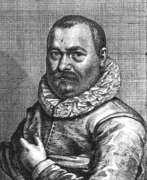

Roelant Savery was a Flanders-born Dutch Golden Age painter.
Savery primarily painted landscapes in the Flemish tradition of Gillis van Coninxloo, often embellished with many meticulously painted animals and plants, regularly with a mythological or biblical theme as background. He also painted multiple flower still lifes; bouquets in stone niches, sometimes with lizards such as Flowers with Two Lizards, insects or fallen petals and regarded as his best work.
His unique style of painting, related to the then reigning Mannerism, has been highly popular with collectors and can be found in many museums in Europe and North America. His preparatory drawings are also valued highly.
